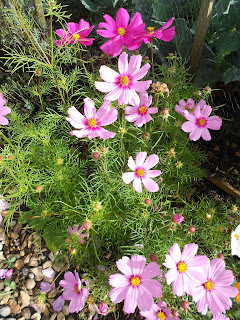The allotment is looking wonderful at the moment, albeit
everything is probably four weeks behind in development due to the cold summer we’ve
had so far.
Looking at the healthy crops, the half decent soil, the
lovely flowers covered in bees, it’s hard to believe that just 4 years ago this
whole area was a stony field, covered in weeds and grass. What is more, it was
a quagmire!! One very wet day when it seemed, at last, that we may be allowed
to move over from our existing allotments, I climbed the gate and started
walking into the field to get a closer look at what we may have to work with.
Soon I was sinking into what felt like sinking sands!! Only it was really
sticky boggy clay, with a consistency I can only describe as “gloopy”! How
different it is now!

As we started digging our plots over that first winter of
occupation, we were soon rewarded by the song of a skylark high above us, come
to see what was going on. Of course it didn’t take long for the pigeons to visit
as well, in their droves. Locust like, they can be guaranteed to appear as soon
as some unsuspecting “plotter” plants out any kind of brassica, without
protection, when these pesky birds come down to strip the plants bare to the
midribs of the leaves. But we have netting and scarecrows and glistening CDs
and other ideas to help keep the pigeons away, some methods more effective than
others.
Now a friendly robin sometimes comes to see me while I’m
working. She probably nests in one of the sheds dotted around the site. And we
have pheasants galore! Beautiful birds, I don’t think they do much harm to
crops, although I’m convinced that they eat my organic slug pellets that I put
down!
So work is now going on in earnest up at the site and soon
I’ll be harvesting strawberries, new potatoes, spinach, beetroot, chives, swiss
chard, and hopefully some courgettes…
























